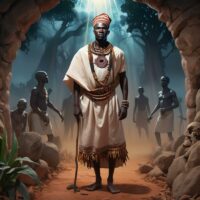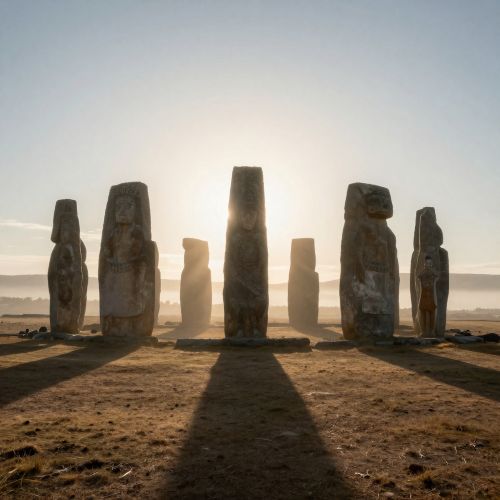Kwase Benefo : The Timeless Hero
Listen
At a glance
| Description | |
|---|---|
| Origin | Ashanti Mythology |
| Classification | Mortals |
| Family Members | N/A |
| Region | Ghana |
| Associated With | Resilience, Will Power |
Kwase Benefo
Introduction
Kwase Benefo, sometimes spelled Kwasi Benefo, is a central figure in Ashanti mythology, originating from present-day Ghana. His story is not just a tale of a grieving man seeking his lost loved ones—it is a profound spiritual narrative that captures the essence of Ashanti beliefs about life, death, and the afterlife. Much like Orpheus in Greek mythology or Inanna in Sumerian lore, Kwase Benefo’s journey to the underworld is both literal and symbolic, reflecting the eternal bond between the living and the departed. His legend offers a window into the cultural, emotional, and metaphysical values of the Ashanti people, making him a vital figure in African folklore.
Physical Traits
Though ancient Ashanti myths do not dwell heavily on detailed physical descriptions, Kwase Benefo is understood to embody the ideal traits of strength, endurance, and prosperity. As a respected farmer and rancher, his success was visible through his fertile lands and flourishing livestock. These elements are not just status markers—they serve as metaphors for his deep connection to the earth, stability, and abundance, which are core values in Ashanti society.
In traditional Ashanti art, heroic or noble figures are often represented with stylized forms—broad foreheads, calm expressions, and poised stances—to symbolize wisdom, peace, and inner strength. While not explicitly confirmed, it’s reasonable to imagine Kwase Benefo depicted similarly in oral retellings and visual culture. These artistic motifs reinforce his character not merely as a man of stature but as someone destined to transcend earthly limits.
Family
What drives Kwase Benefo’s mythic quest is not ambition or vengeance, but love and loss. His story revolves around a series of personal tragedies—four wives, all of whom die under different, sorrowful circumstances. These repeated losses aren’t merely unfortunate plot points—they reflect a deeper cultural reverence for the bond between spouses and the belief that love transcends the boundary of life and death.
In Ashanti society, lineage follows a matrilineal structure, meaning inheritance and identity are traced through the mother’s line. Despite this, Kwase Benefo’s devotion to his wives and his desire to reunite with them even after their deaths suggests a universal truth in Ashanti cosmology: family is sacred, and emotional ties don’t end with death. When his fourth wife dies, Kwase Benefo leaves his surviving child with her relatives, ensuring that tradition and care persist even in his absence. This aspect of the myth underscores the Ashanti emphasis on continuity and kinship, which often extend beyond the physical realm.
Other names
Kwase Benefo is sometimes referred to as Kwasi Benefo, a variation stemming from Akan linguistic traditions. In Ghana, names carry deep spiritual and cultural significance, often connected to the day of the week a person is born. The names “Kwase” and “Kwasi” both derive from the same root, indicating a male born on Sunday.
These slight variations in spelling are common in oral traditions, where pronunciation and dialect can shift from one region or speaker to another. Despite these differences, both versions of his name reflect the same mythic persona—one that embodies persistence, loyalty, and a uniquely African perspective on mortality and memory. The survival of his name across generations shows the power of oral tradition in preserving cultural identity.
Powers and Abilities
Although Kwase Benefo is not a god or demigod, his story elevates him to near-legendary status through his spiritual courage. After enduring profound grief, he decides to journey into Asamando, the Ashanti underworld. This is no small feat; entering the realm of the dead while still alive is viewed as both forbidden and incredibly dangerous.
What sets Kwase Benefo apart is not supernatural power, but unyielding determination. He meets Amokye, the psychopomp who guides souls to the afterlife. Convincing Amokye to allow him entry showcases not just bravery, but deep spiritual resonance—a mortal who is willing to risk everything for the sake of love.
His interactions in the underworld also imply a kind of spiritual literacy; he navigates the unseen realm with respect, courage, and reverence. This journey, filled with emotional trials and metaphysical tests, highlights Kwase Benefo as a symbol of human resilience in the face of cosmic odds. In Ashanti mythology, very few heroes earn the privilege of bridging the gap between life and death—Kwase Benefo’s success in doing so marks him as exceptional.
Modern Day Influence
Though his tale is centuries old, Kwase Benefo’s story continues to resonate in modern times, particularly as interest in African mythology grows globally. Scholars, artists, and storytellers are revisiting his legend not only to preserve cultural heritage but to reimagine it for new generations.
His myth has been included in books that explore the deeper meanings of African mythologies, such as The Hero with an African Face, which places Kwase Benefo alongside other world mythological figures in discussions of death, transformation, and spiritual rebirth. His journey is now viewed as a template for storytelling that blends emotional realism with metaphysical depth.
In the digital age, his narrative has also inspired reinterpretations in modern media—from graphic novels to animated stories—where African heroes are gaining space in a storytelling landscape often dominated by Western mythologies. These adaptations help younger audiences connect with their heritage in new ways, making Kwase Benefo not just a relic of the past, but a living symbol of cultural resilience.
Related Images
Source
Contributors to Wikimedia projects. (2021). Kwase Benefo – Wikipedia. https://en.wikipedia.org/wiki/Kwase_Benefo
Katarzyna Bazylczyk, Rafal Lempicki. (2018). Kwasi Benefo – Entry details | Our Mythical Childhood Survey. http://www.omc.obta.al.uw.edu.pl/myth-survey/item/178
The Hero’s Journey | Robert B. Sloan. (2021). https://robertbsloan.com/2021/09/30/the-heros-journey/
Kwasi Wiredu and the Search for Authentic African Philosophy – Qazini. (2025). https://www.qazini.com/kwasi-wiredu-and-the-search-for-authentic-african-philosophy
Related Articles. (n.d.). The Hero with an African Face. https://penguinrandomhousehighereducation.com/book/?isbn=9780553378689
Frequently Asked Questions
What is lorem Ipsum?
I am text block. Click edit button to change this text. Lorem ipsum dolor sit amet, consectetur adipiscing elit. Ut elit tellus, luctus nec ullamcorper mattis, pulvinar dapibus leo.
What is lorem Ipsum?
I am text block. Click edit button to change this text. Lorem ipsum dolor sit amet, consectetur adipiscing elit. Ut elit tellus, luctus nec ullamcorper mattis, pulvinar dapibus leo.
What is lorem Ipsum?
I am text block. Click edit button to change this text. Lorem ipsum dolor sit amet, consectetur adipiscing elit. Ut elit tellus, luctus nec ullamcorper mattis, pulvinar dapibus leo.
What is lorem Ipsum?
I am text block. Click edit button to change this text. Lorem ipsum dolor sit amet, consectetur adipiscing elit. Ut elit tellus, luctus nec ullamcorper mattis, pulvinar dapibus leo.
What is lorem Ipsum?
I am text block. Click edit button to change this text. Lorem ipsum dolor sit amet, consectetur adipiscing elit. Ut elit tellus, luctus nec ullamcorper mattis, pulvinar dapibus leo.





